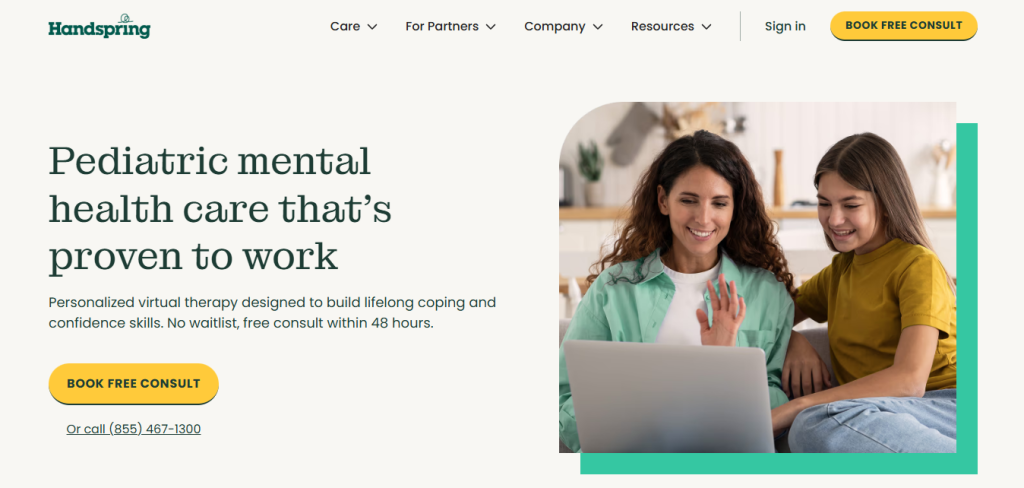Handspring Health Raises $12M Series A to Expand Accessible Mental Healthcare for Youth
July 6, 2025
byFenoms Startup Research

Handspring Health, a mission-driven startup focused on delivering high-quality mental health care for children, adolescents, and families, has raised $12 million in Series A funding. The round includes backing from notable investors such as Cobalt Ventures, NextView Ventures, nvp capital, 25madison, Arkitekt Ventures, VamosVentures, Hyde Park Angels (HPA), and Cornucopian Capital.
Led by co-founders Sahil Choudhry and Kwasi Kyei, Handspring is tackling one of the most urgent and underserved challenges in American healthcare: the pediatric mental health crisis.
Addressing the Youth Mental Health Crisis at Scale
Handspring Health provides evidence-based, personalized mental health care for children, teens, and their families - with a hybrid care model that combines in-person clinics and telehealth flexibility. Their services span anxiety, depression, ADHD, behavioral challenges, and more, all grounded in a family-centered approach.
This model isn’t just about therapy. It’s about building an infrastructure of long-term emotional wellness, supported by licensed clinicians and backed by outcomes-based care.
The need is overwhelming. According to the CDC, more than 20% of children in the U.S. face a diagnosable mental health disorder each year. And yet, over 70% of those kids never receive timely or adequate treatment. Add the fact that suicide is now the second leading cause of death for those aged 10–24, and it’s clear that the system is buckling under pressure.
Where Others Built Platforms, Handspring Built a System
Most digital mental health startups in the last five years have aimed at scaling access through software. Handspring didn’t stop there. They reimagined the care model itself - clinically integrated, family-oriented, and payer-aligned.
The difference shows up not in just usage metrics, but in clinical retention, improved family outcomes, and stronger insurance coverage rates. Handspring’s model is working not only because it’s tech-enabled - but because it’s operationally grounded in the real-world dynamics of families, schools, and clinicians.
This is what most founders building in healthcare miss: fixing access is only the first mile - fixing alignment is the next hundred. Handspring didn’t try to bypass the system; they built around its complexity. Their clinics are reimbursed by insurers, trusted by pediatricians, and preferred by families. That’s not just product-market fit - it’s system-market fit.
And that’s the ultra value drop: in healthcare, founders often try to innovate around the system - but the real leverage comes from engineering the system to work for you. Reimbursement, staffing, outcomes, and user trust aren’t side quests - they are the core product. The startups that win are those who align every layer of the stack - from software to care delivery to payment logic.
Why Investors Are Betting Big Now
The $12M Series A marks a growing wave of capital flowing into youth-focused healthcare innovation. Investors backing this round include:
- Cobalt Ventures – the VC arm of Blue Cross and Blue Shield of Kansas City
- NextView Ventures – focused on the everyday economy
- nvp capital, 25madison, Arkitekt Ventures, VamosVentures
- Hyde Park Angels (HPA) and Cornucopian Capital, rounding out a strong mission-aligned syndicate
This round will power Handspring’s geographic expansion, deepen its hybrid care offering, and scale its tech-enabled service model nationwide.
A Sector Ready for Disruption
Mental and behavioral health has consistently ranked among the top three categories in digital health VC funding. In 2023 alone, $2.1 billion went into behavioral health startups (Rock Health). But the vast majority of these solutions skew adult-focused, app-based, or direct-to-consumer - leaving an enormous care gap for young people.
At the same time, Medicaid and commercial insurers are increasingly demanding value-based mental health delivery, especially for youth populations. Handspring’s insurance-first model positions it to thrive under emerging payment models and public-private partnerships.
DAOs now manage over $30 billion in treasury assets and coordinate thousands of contributors globally. Yet despite this scale, most DAOs still operate with duct-taped processes, fragmented software, and legal uncertainty. Castle is directly targeting this gap.
What’s Next for Handspring Health
With new funding in place, Handspring plans to:
- Open new clinics in regions with high unmet pediatric needs
- Expand its hybrid model, making therapy more flexible and family-inclusive
- Grow its clinical workforce by supporting and retaining licensed therapists and child psychologists
- Deepen payer partnerships to advance value-based mental health delivery
- Invest in tech that supports measurement-based outcomes and care personalization
The team is also exploring partnerships with school systems, pediatric hospitals, and community organizations to build a truly integrated care network that meets families where they are—before crises happen.









